Atlantic horseshoe crab
| Atlantic horseshoe crab | |
|---|---|
.jpg) | |
| Scientific classification | |
| Kingdom: | Animalia |
| Phylum: | Arthropoda |
| Subphylum: | Chelicerata |
| Class: | Merostomata |
| Order: | Xiphosura |
| Family: | Limulidae |
| Genus: | Limulus O. F. Müller, 1785 |
| Species: | L. polyphemus |
| Binomial name | |
| Limulus polyphemus (Linnaeus, 1758) | |
| Synonyms | |
|
Monoculus polyphemus Linnaeus, 1758 | |
The Atlantic horseshoe crab (Limulus polyphemus) is a marine chelicerate arthropod. Despite its name, it is more closely related to spiders, ticks, and scorpions than to crabs.[2] Horseshoe crabs are most commonly found in the Gulf of Mexico and along the northern Atlantic coast of North America. A main area of annual migration is Delaware Bay, although stray individuals are occasionally found in Europe.[3]
The other three extant species in the family Limulidae are also called horseshoe crabs.[4] These are Tachypleus tridentatus, Tachypleus gigas and Carcinoscorpius rotundicauda, which all are restricted to Asia.[4][5] All four are quite similar in form and behavior.
Names and classification
_(5).jpg)
This group of animals is also known as horsefoot, or saucepan. Some people call the horseshoe crab a "helmet crab", but this common name is more frequently applied to a true crab, a malacostracan, of the species Telmessus cheiragonus. The term "king crab" is sometimes used for horseshoe crabs, but it is more usually applied to a group of decapod crustaceans.
Limulus means "askew"[6] and polyphemus refers to the giant in Greek mythology.[6] It is based on the misconception that the animal had a single eye.
Former scientific names include Limulus cyclops, Xiphosura americana, and Polyphemus occidentalis.
It is the tail that earns this order its name Xiphosura, which derives from the Greek for 'sword tail'.
Anatomy and physiology
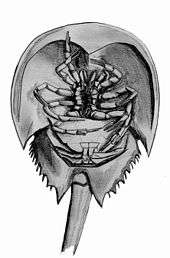
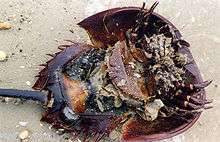

Horseshoe crabs have three main parts to the body: the head region, known as the "prosoma", the abdominal region or "opisthosoma", and the spine-like tail or "telson". The smooth shell or carapace is shaped like a horseshoe, and is greenish grey to dark brown in colour. The sexes are similar in appearance, but females are typically 25 to 30% larger than the male and can grow up to 60 cm (24 in) in length (including tail).[7]
Horseshoe crabs possess the rare ability to regrow lost limbs, in a manner similar to sea stars.[8]
A wide range of marine species become attached to the carapace, including algae, flat worms, mollusks, barnacles, and bryozoans, and horseshoe crabs have been described as 'walking museums' due to the number of organisms they can support.[9] In areas where Limulus is common, the shells, exoskeletons or exuviae (molted shells) of horseshoe crabs frequently wash up on beaches, either as whole shells, or as disarticulated pieces.
The brain and the heart are located in the prosoma. On the underside of the prosoma, six pairs of appendages occur, the first of which (the small pincers or chelicerae) are used to pass food into the mouth, which is located in the middle of the underside of the cephalothorax, between the chilicerae. Although most arthropods have mandibles, the horseshoe crab is jawless.
The second pair of appendages, the pedipalps, are used as walking legs; in males they are tipped with 'claspers', which are used during mating to hold onto the female's carapace. The remaining four pairs of appendages are the 'pusher legs', also used in locomotion. The first four pairs of legs have claws, the last pair has a leaf-like structure used for pushing.[10]
The opisthosoma bears a further six pairs of appendages; the first pair houses the genital pores, while the remaining five pairs are modified into flattened plates, known as book gills, that allow them to breathe underwater, and can also allow them to breathe on land for short periods of time, provided the gills remain moist.
The telson (i.e., tail or caudal spine) is used to steer in the water and also to flip itself over if stuck upside down.
Among other senses, they have a small chemoreceptor organ that senses smells on the triangular area formed by the exoskeleton beneath the body near the ventral eyes.[11]
Vision
Limulus has been extensively used in research into the physiology of vision. The Nobel prize in Medicine was awarded in 1967 in part for research performed on the horseshoe eye.
A large compound eye with monochromatic vision is found on each side of the prosoma;[note 1][12] it has five simple eyes on the carapace, and two simple eyes on the underside, just in front of the mouth,[12] making a total of nine eyes. The simple eyes are probably important during the embryonic or larval stages of the organism,[12] and even unhatched embryos seem to be able to sense light levels from within their buried eggs.[13] The less sensitive compound eyes, and the median ocelli, become the dominant sight organs during adulthood.[12]
In addition, the tail bears a series of light-sensing organs along its length.
Each compound eye is composed of about 1000 receptors called ommatidia,[10] complex structures consisting of upwards of 300 cells.[13] The ommatidia are somewhat messily arranged, not falling into the ordered hexagonal pattern seen in more derived arthropods.[12] Each ommatidium feeds into a single nerve fiber. Furthermore, the nerves are large and relatively accessible. This made it possible for electrophysiologists to record the nervous response to light stimulation easily, and to observe visual phenomena such as lateral inhibition working at the cellular level. More recently, behavioral experiments have investigated the functions of visual perception in Limulus. Habituation and classical conditioning to light stimuli have been demonstrated, as has the use of brightness and shape information by males when recognizing potential mates.
| Part of a series on |
| Seashells |
|---|
 |
| Mollusc shells |
| About mollusc shells |
| Other seashells |
The retinula (literally, "small retina") cells of the ommatidium of the compound eye contain areas from which membranous organelles of conceivable size (rhabdomeres) extend. Rhabdomeres have tiny microvilli (tiny tubes extending out of the retinula) that interlock with neighboring retinular cells. This forms the rhabdom, which contains the dendrite of the eccentric cell, and may also contribute some microvilli. The only other species with an eccentric cell is the silkworm moth. Microvilli are composed of a double layer, 7 nm each and with 3.5 nm space of two electron-deficient boundaries in between. Where the microvilli meet, these outer borders fuse and yield five membranes about 15 nm thick. In all arthropods, there is always a rhabdom below a crystalline cone, on or near the center of the ommatidium, and always aligned with the path of light. At right angles to the length of the rhabdome are the length of the microvilli, which are in line with each other. The microvilli are about 40–150 nm in diameter.[14]
Blood
The blood of horseshoe crabs (as well as that of most mollusks, including cephalopods and gastropods) contains the copper-containing protein hemocyanin at concentrations of about 50 g per liter.[15] These creatures do not have hemoglobin (iron-containing protein), which is the basis of oxygen transport in vertebrates. Hemocyanin is colorless when deoxygenated and dark blue when oxygenated. The blood in the circulation of these creatures, which generally live in cold environments with low oxygen tensions, is grey-white to pale yellow,[15] and it turns dark blue when exposed to the oxygen in the air, as seen when they bleed.[15] Hemocyanin carries oxygen in extracellular fluid, which is in contrast to the intracellular oxygen transport in vertebrates by hemoglobin in red blood cells.[15]
The blood of horseshoe crabs contains one type of blood cell, the amebocytes. These play an important role in the defense against pathogens. Amebocytes contain granules with a clotting factor known as coagulogen; this is released outside the cell when bacterial endotoxin is encountered.[16] The resulting coagulation is thought to contain bacterial infections in the animal's semiclosed circulatory system.[17]
Life cycle and behavior
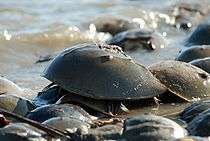 | |
|
| |
|
| |
|
|
The crab feeds on mollusks, annelid worms, other benthic invertebrates, and bits of fish. Lacking jaws, it grinds up the food with bristles on its legs and a gizzard that contains sand and gravel.[7]
They spend the winters on the continental shelf and emerge at the shoreline in late spring to spawn, with the males arriving first. The smaller male grabs on to the back of a female with a "boxing glove" like structure on his front claws, often holding on for months at a time. Often several males will hold on to a single female.[18] Females reach the beach at high tide.[18] After the female has laid a batch of eggs in a nest at a depth of 15–20 cm in the sand, the male or males fertilize them with their sperm.[18] Egg quantity is dependent on the female's body size, and ranges from 15,000 to 64,000 eggs per female.[19]
"Development begins when the first egg cover splits and new membrane, secreted by the embryo, forms a transparent spherical capsule" (Sturtevant). The larvae form and then swim for about five to seven days. After swimming, they settle, and begin the first molt. This occurs about 20 days after the formation of the egg capsule. As young horseshoe crabs grow, they move to deeper waters, where molting continues. Before becoming sexually mature around age 9, they have to shed their shells some 17 times.[7] Longevity is difficult to assess, but the average lifespan is thought to be 20–40 years.[20]
Research from the University of New Hampshire gives insight into the circadian rhythms of American horseshoe crabs. For example, several studies have looked into the effect of a circa tidal rhythm on the locomotion of Limulus polyphemus While it has been known for a while that a circadian clock system controls eye sensitivity, scientists discovered a separate clock system for locomotion.[21] When a sample of horseshoe crabs were exposed to artificial tidal cycles in the lab, circa tidal rhythms were observed. The study found that light and dark cycles influence locomotion in Limulus polyphemus, but not as much as tidal activity.[22]
Evolution
Horseshoe crabs were traditionally grouped with the extinct eurypterids (sea scorpions) as the Merostomata. They may have evolved in the shallow seas of the Paleozoic Era (570–248 million years ago) with other primitive arthropods like the trilobites. The four species of horseshoe crab are the only remaining members of the Xiphosura, one of the oldest classes of marine arthropods.
The extinct diminutive horseshoe crab, Lunataspis aurora, 4 centimetres (1.6 in) from head to tail-tip, has been identified in 445-million-year-old Ordovician strata in Manitoba.[23]
Horseshoe crabs are often referred to as living fossils, as they have changed little in the last 445 million years.[7] Forms almost identical to this species were present during the Triassic period 230 million years ago, and similar species were present in the Devonian, 400 million years ago. However, the Atlantic horseshoe crab itself has no fossil record at all, and the genus Limulus "ranges back only some 20 million years, not 200 million."[24]
Medical uses
Horseshoe crabs are valuable as a species to the medical research community, and in medical testing. The above-mentioned clotting reaction of the animal's blood is used in the widely used Limulus amebocyte lysate (LAL) test to detect bacterial endotoxins in pharmaceuticals and to test for several bacterial diseases.[6]
Enzymes from horseshoe crab blood are used by astronauts in the International Space Station to test surfaces for unwanted bacteria and fungi.[25]
A protein from horseshoe crab blood is also under investigation as a novel antibiotic.[18]
LAL is obtained from the animals' blood. Horseshoe crabs are returned to the ocean after bleeding. Studies show the blood volume returns to normal in about a week, though blood cell count can take two to three months to fully rebound.[26]
Conservation and management
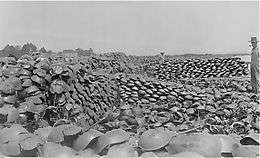

Early in the 20th century and possibly before, there was the mistaken belief in some areas that horseshoe crabs were destructive to fisheries, folklore held that they used their long spines to drill into some shellfish. Because of this mistaken belief and folklore, bounties were sometimes offered by authorities for them. On Cape Cod in the early 20th century five cents was offered for every dead horseshoe crab turned in.
Limulus polyphemus is not presently endangered, but harvesting and habitat destruction have reduced its numbers at some locations and caused some concern for this animal's future. Since the 1970s, the horseshoe crab population has been decreasing in some areas, due to several factors, including the use of the crab as bait in eel, whelk and conch trapping.
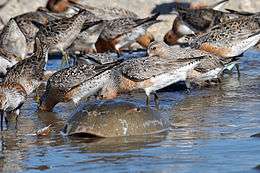
Conservationists have also voiced concerns about the declining population of shorebirds, such as red knots, which rely heavily on the horseshoe crabs' eggs for food during their spring migration. Precipitous declines in the population of the red knots have been observed in recent years. Predators of horseshoe crabs, such as the currently threatened Atlantic loggerhead turtle, have also suffered as crab populations diminish.[28]
In 1995, the nonprofit Ecological Research and Development Group (ERDG) was founded with the aim of preserving the four remaining species of horseshoe crab.[29] Since its inception, the ERDG has made significant contributions to horseshoe crab conservation. ERDG founder Glenn Gauvry designed a mesh bag for whelk/conch traps, to prevent other species from removing the bait. This has led to a decrease in the amount of bait needed by approximately 50%. In the state of Virginia, these mesh bags are mandatory in whelk/conch fishery. The Atlantic States Marine Fisheries Commission in 2006 considered several conservation options, among them being a two-year ban on harvesting the animals, affecting both Delaware and New Jersey shores of Delaware Bay.[30] In June 2007, Delaware Superior Court Judge Richard Stokes has allowed limited harvesting of 100,000 males. He ruled that while the crab population was seriously depleted by overharvesting through 1998, it has since stabilized, and that this limited take of males will not adversely affect either horseshoe crab or red knot populations. In opposition, Delaware environmental secretary John Hughes concluded that a decline in the red knot bird population was so significant that extreme measures were needed to ensure a supply of crab eggs when the birds arrived.[31][32] Harvesting of the crabs was banned in New Jersey March 25, 2008.[33]
Every year, about 10% of the horseshoe crab breeding population dies when rough surf flips the creatures onto their backs, a position from which they often cannot right themselves. In response, the ERDG launched a "Just Flip 'Em" campaign, in the hopes that beachgoers will simply turn the crabs back over.
A large-scale project to tag and count horseshoe crabs along the North American coast was underway in the spring and summer of 2008, termed projectlimulus.org.[7] Due to the lack of information and knowledge regarding horseshoe crab populations, the management policies lack any abundance of rules and regulations. To implement management policies for the species, more population information needs to be obtained.[34]
Notes
- ↑ Peak absorption is at 525 nm
References
- ↑ World Conservation Monitoring Centre (1996). "Limulus polyphemus". IUCN Red List of Threatened Species. Version 2009.2. International Union for Conservation of Nature. Retrieved February 25, 2010.
- ↑ Chliboyko, J. "Crabby Ancestors", Canadian Geographic Magazine, April 2008, p. 25
- ↑ "NEAT Chelicerata and Uniramia Checklist" (PDF). Retrieved October 24, 2006.
- 1 2 "The Horseshoe Crab Natural History: Crab Species". Archived from the original on 12 February 2007. Retrieved 2007-03-01.
- ↑ Basudev Tripathy (2006). "In-House Research Seminar: The status of horseshoe crab in east coast of India". Wildlife Institute of India: 5. Archived from the original on 2011-07-21.
- 1 2 3 Coast by Willie Heard
- 1 2 3 4 5 Angier, Natalie (June 10, 2008). "Tallying the Toll on an Elder of the Sea". The New York Times. ISSN 0362-4331. Archived from the original on September 29, 2013. Retrieved June 11, 2008.
- ↑ Misty Edgecomb (June 21, 2002). "Horseshoe Crabs Remain Mysteries to Biologists". Bangor Daily News (Maine), repr. National Geographic News. p. 2.
- ↑ Susan M. Wells; Robert M. Pyle; N. Mark Collins (1983). The IUCN Invertebrate Red Data Book. IUCN. p. 235.
- 1 2 Anatomy of the Horseshoe Crab, Maryland Department of Natural Resources. Retrieved 12 August 2008.
- ↑ Elizabeth Quinn; Kristen Paradise & Jelle Atema (1998). "Juvenile Limulus polyphemus generate two water currents that contact one proven and one putative chemoreceptor organ". The Biological Bulletin. 195 (2): 185–187. doi:10.2307/1542829. JSTOR 1542829.
- 1 2 3 4 5 Battelle, B.A. (December 2006). "The eyes of Limulus polyphemus (Xiphosura, Chelicerata) and their afferent and efferent projections". Arthropod Structure & Development. 35 (4): 261–274. doi:10.1016/j.asd.2006.07.002. PMID 18089075.
- 1 2 Harzsch, S.; Hafner, G. (2006). "Evolution of eye development in arthropods: phylogenetic aspects". Arthropod Structure & Development. 35 (4): 319–340. doi:10.1016/j.asd.2006.08.009. PMID 18089079.
- ↑ "Photoreception" McGraw-Hill Encyclopedia of Science & Technology, vol. 13, p. 461 2007
- 1 2 3 4 Shuster, Carl N (2004). "Chapter 11: A blue blood: the circulatory system". In Shuster, Carl N Jr; Barlow, Robert B; Brockmann, H. Jane. The American horseshoe crab. Harvard University Press. pp. 276–277. ISBN 0-674-01159-7.
- ↑ Mürer, EH; Levin, J; Holme, R (December 1975). "Isolation and studies of the granules of the amebocytes of Limulus polyphemus, the horseshoe crab.". Journal of cellular physiology. 86 (3 Pt 1): 533–42. doi:10.1002/jcp.1040860310. PMID 413.
- ↑ "The Rabbit and the Horse Shoe Crab". 23 September 2014. Retrieved 7 March 2015.
- 1 2 3 4 Sandy Huff (April 11, 2004), "Crab Watch", Tampa Tribune
- ↑ Leschen, A. S.; et al. (2006). "Fecundity and spawning of the Atlantic horseshoe crab, Limulus polyphemus, in Pleasant Bay, Cape Cod, Massachusetts, USA". Marine Ecology. 27: 54–65. doi:10.1111/j.1439-0485.2005.00053.x.
- ↑ "Horseshoe crab (Limulus polyphemus)". ARKive. Retrieved March 28, 2010.
- ↑ Chabot, CC; Watson, Win III (2010). "Circatidal rhythms of locomotion in the American horseshoe crab, Limulus polyphemus: Underlying mechanisms and cues that influence them". Current Zoology. 56 (5): 499–517.
- ↑ Chabot, CC; Watson, Win III (2008). "Artificial tides synchronize circatidal rhythms of locomotion in the American horseshoe crab, Limulus polyphemus". The Biological Bulletin. 215: 24–25. doi:10.2307/25470681.
- ↑ "Ancient horseshoe crabs get even older". Fox News. January 30, 2008.
- ↑ Stephen Jay Gould (1989). Wonderful life: The Burgess Shale and the nature of history. New York: W. W. Norton & Co. p. 43. ISBN 0-393-02705-8.
- ↑ "Astronauts Swab the Deck". NASA. Retrieved February 6, 2009.
- ↑ "Medical Uses". Ecological Research and Development Group. Archived from the original on 28 February 2008. Retrieved February 21, 2008.
- ↑ The Blood Harvest, The Atlantic magazine, Feb. 2014
- ↑ Juliet Eilperin (June 10, 2005). "Horseshoe Crabs' Decline Further Imperils Shorebirds (subtitle: Mid-Atlantic States Searching for Ways to Reverse Trend)". The Washington Post. p. A03. Retrieved May 14, 2006.
- ↑ "About ERDG". horseshoecrab.org. ERDG. Retrieved 31 January 2015.
- ↑ Molly Murray (May 5, 2006). "Seafood dealer wants to harvest horseshoe crabs (subtitle: Regulators look at 2-year ban on both sides of Delaware Bay)". The News Journal. pp. B1, B6.
- ↑ "Horseshoe Crabs in Political Pinch Over Bird's Future / Creature is Favored Bait On Shores of Delaware; Red Knot Loses in Court". The Wall Street Journal. June 11, 2007. pp. A1, A10.
- ↑ "Judge dumps horseshoe crab protection". Charlotte Observer. Associated Press.
- ↑ "NJ to ban horseshoe crabbing...". Philly Burbs.Com. Associated Press. Archived from the original on 2009-01-16.
- ↑ "Atlantic States Marine Fisheries Commission: Horseshoe Crab". Retrieved June 30, 2009.
Bibliography
- Richard Owen (1873). Anatomy of the king crab (Limulus polyphemus, Latr.). London: Taylor and Francis.
Further reading
 Chisholm, Hugh, ed. (1911). "King-Crab". Encyclopædia Britannica (11th ed.). Cambridge University Press.
Chisholm, Hugh, ed. (1911). "King-Crab". Encyclopædia Britannica (11th ed.). Cambridge University Press.
External links
| External identifiers for Limulus polyphemus | |
|---|---|
| Encyclopedia of Life | 393278 |
| ITIS | 82703 |
| NCBI | 6850 |
| WoRMS | 150514 |
| Also found in: Wikispecies | |
| Wikimedia Commons has media related to Limulus polyphemus. |
- "The Horseshoe Crab: Natural History, Anatomy, Conservation and Current Research". Ecological Research and Development Group. 2003. Archived from the original on 24 April 2006. Retrieved May 14, 2006.
- The Alarming Decrease in Population.
- Biomedical Eye Research
- Earth Matters Foundation Horseshoe Crab Campaign.
- All about the horseshoe crab.
- The Crabs, The Birds, The Bay. Short film about migrating shorebirds feasting on horseshoe crab eggs in Delaware Bay.
- Blue Blood 3min clip from Nature (TV series)
- Return of the Sandpiper, Abigail Tucker, with photographs by Doug Gritzmacher, Smithsonian magazine, October 2009.
- projectlimulus.org
